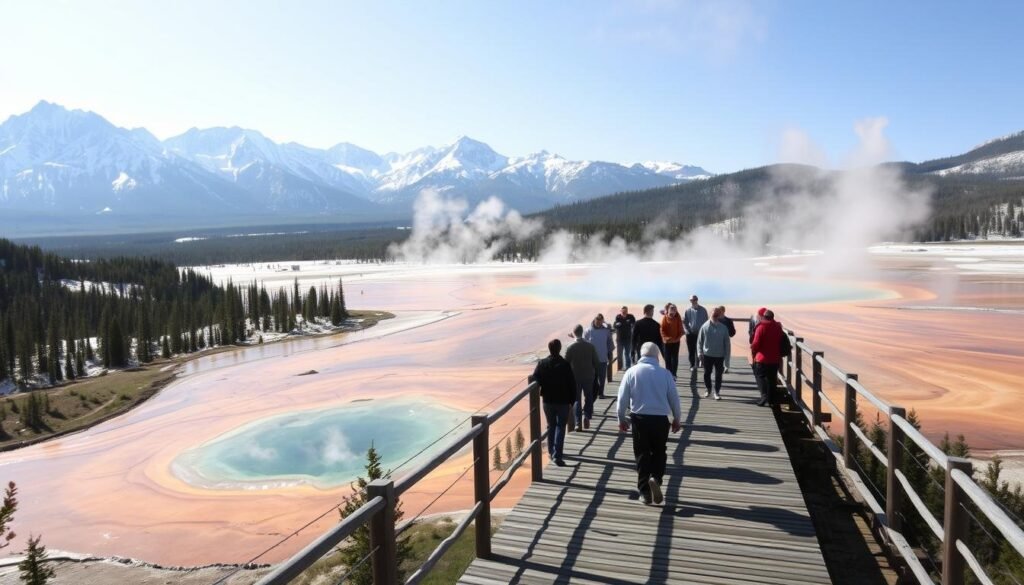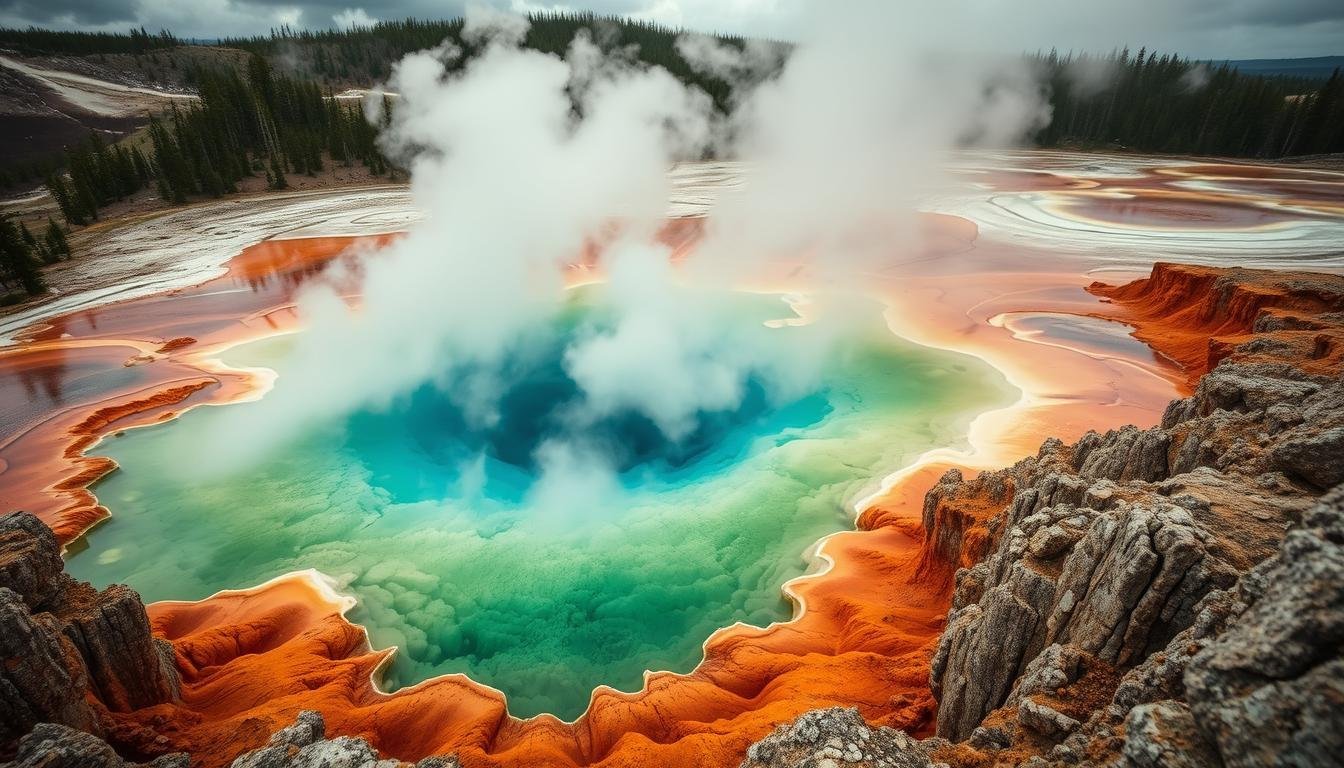Why the Grand Prismatic Spring is Dangerous? Visiting Yellowstone National Park is a dream for many. It’s home to breathtaking natural wonders like the Grand Prismatic Spring. This vibrant attraction draws millions each year. But, beneath its mesmerizing colors, dangers hide.
When planning your visit, knowing the hazards is key. The Grand Prismatic Spring is beautiful but risky. It’s important to understand these risks for a safe visit.
By learning about Yellowstone hazards and taking precautions, you can enjoy the Spring safely. This way, you can fully appreciate its beauty.
Contents
- 1 The Mesmerizing Beauty of Grand Prismatic Spring
- 2 Why Is the Grand Prismatic Spring So Dangerous?
- 3 The Science Behind the Hazards
- 4 Documented Accidents and Fatalities
- 5 Yellowstone’s Safety Regulations and Enforcement
- 6 Essential Safety Precautions for Your Visit
- 7 Emergency Procedures and First Aid
- 8 Conclusion: Enjoying Nature’s Wonders Responsibly
- 9 FAQ
- 9.1 What are the main hazards associated with visiting the Grand Prismatic Spring?
- 9.2 What is the temperature of the water in the Grand Prismatic Spring?
- 9.3 Why is it essential to stay on designated trails when visiting the Grand Prismatic Spring?
- 9.4 What safety regulations are in place for visiting the Grand Prismatic Spring?
- 9.5 What should I do in case of an emergency at the Grand Prismatic Spring?
- 9.6 Can I touch or enter the Grand Prismatic Spring?
- 9.7 How can I minimize my risk of injury when visiting the Grand Prismatic Spring?
- 9.8 Are there any documented cases of accidents or fatalities at the Grand Prismatic Spring?
The Mesmerizing Beauty of Grand Prismatic Spring
The Grand Prismatic Spring’s colors will amaze you. They come from microorganisms and how light scatters. Walking around, the colors seem to change, offering a unique sight.
The colors are not just pretty. They show the spring’s special biology and chemistry. Microorganisms like cyanobacteria and archaea add to the colors.
The Science Behind the Colors
The colors of the Grand Prismatic Spring come from light and microorganisms in the water. Light scattering creates the bright colors we see.
Learning about the science behind the colors makes your visit to Yellowstone unforgettable.
Why Is the Grand Prismatic Spring So Dangerous?
When you get close to the Grand Prismatic Spring, it’s key to know the dangers. The water is scorching hot, up to 160°F (71°C). This makes it one of Yellowstone’s hottest springs.
This high heat is a big risk for visitors. It can cause serious burns if you touch it. Also, the ground around the spring is thin and can hide deep cracks and crevices. These can be very dangerous to walk on.
The ground’s fragility comes from the area’s unique geology. The spring’s colors come from microorganisms and the water’s chemical makeup. Visitors need to be careful not to leave the paths to avoid accidents.
The Grand Prismatic Spring is always changing. Weather and geological activity can change its conditions. This means the risks for visitors can also change. It’s important to stay alert at all times.
To stay safe, visitors should keep up with current conditions. They should also follow the safety rules given by park authorities. Knowing the dangers helps you enjoy the spring’s beauty while staying safe.
The Science Behind the Hazards
Exploring the Grand Prismatic Spring requires understanding its hazards. It showcases Yellowstone’s unique Yellowstone geology and significant thermal activity.
The spring’s water is heated by Yellowstone’s volcanic activity. This creates a complex environment where geochemical processes are key.
Geochemical Processes
The spring’s colors and thermal activity come from geochemical processes. Microorganisms in the hot water produce pigments, making it colorful.
The hot water, minerals, and microorganisms create a unique environment. Knowing these geochemical processes and thermal activity helps us appreciate the dangers. It also helps us take the right precautions.
Documented Accidents and Fatalities
Visitors to the Grand Prismatic Spring have faced serious risks, leading to documented accidents and fatalities. The hot springs, including the Grand Prismatic Spring, are very dangerous. This is because of their extreme temperatures and fragile ground.
There have been cases where visitors got severe burns from falling into the hot water. The ground around these springs is thin and can break easily. Also, the water in these springs is not only hot but also contains harmful chemicals.
Looking at these incidents shows how crucial it is to follow safety guidelines and rules. Visitors need to be aware of their surroundings and stick to park rules. This way, you can enjoy the beauty of the Grand Prismatic Spring while staying safe.
Some incidents include visitors straying from designated paths and falling into the hot springs. These cases highlight the need for caution and following safety guidelines. By being aware of the risks, you can help prevent such accidents.
Yellowstone’s Safety Regulations and Enforcement
Yellowstone National Park has rules to keep visitors safe, especially near attractions like the Grand Prismatic Spring. Knowing these rules is important for a safe and fun visit.
The park has rules to protect visitors, like staying on trails and listening to park rangers. These safety guidelines are very important in areas that are delicate and dangerous.
Enforcement Measures
Yellowstone uses several ways to make sure visitors follow the rules. Park rangers are all over the park to watch over visitors and help them. The park also uses cameras and other systems to spot any safety problems.
| Safety Regulation | Description | Enforcement Measure |
|---|---|---|
| Stay on Designated Trails | Prevents erosion and protects fragile ecosystems | Park Rangers, Signage |
| Follow Instructions from Park Rangers | Ensures visitor safety in hazardous areas | Park Ranger Presence, Public Announcements |
| Surveillance and Monitoring | Identifies potential safety risks | Surveillance Cameras, Monitoring Systems |
By following these safety rules and enforcement, visitors can greatly lower their risk of getting hurt. This way, they can have a safer and more enjoyable time at Yellowstone’s Grand Prismatic Spring.
Essential Safety Precautions for Your Visit
Planning a visit to the Grand Prismatic Spring? It’s important to know the safety rules. This natural wonder is amazing but can be dangerous if not respected.
To stay safe, always follow the trails and keep a distance from the spring. The ground is fragile and can’t hold your weight, which could lead to accidents.
Safety Tips
- Stay on designated boardwalks and trails to avoid accidents.
- Keep a safe distance from the spring to avoid falling into the hot water.
- Be aware of your surroundings, including other visitors and potential hazards.
- Follow instructions from park rangers and safety guidelines.
| Safety Precaution | Importance | Tips |
|---|---|---|
| Staying on Designated Trails | High | Follow marked paths to avoid fragile ground. |
| Keeping a Safe Distance | High | Avoid getting too close to the spring’s edge. |
| Awareness of Surroundings | Medium | Watch for other visitors and potential hazards. |

By following these visitor safety tips and being mindful of your surroundings, you can enjoy the beauty of the Grand Prismatic Spring while minimizing your risk of injury. Preparation is key to a safe and enjoyable visit to Yellowstone.
Emergency Procedures and First Aid
Knowing Yellowstone’s emergency plan is key when near the Grand Prismatic Spring. The park has a detailed response system. It includes trained rangers and first aid spots.
If an emergency happens, knowing how to reach help is vital. Call the park’s emergency number or find a ranger station. The Grand Prismatic Spring area is watched closely, but being ready is best.
Basic first aid can help with small issues during your visit. For bigger problems, get help from park rangers or first aid in the park.
- For minor cuts and scrapes, clean the wound with water and apply a bandage.
- In case of a burn, cool the affected area with cool water and seek shade.
- If you experience any severe symptoms or injuries, immediately contact a park ranger or visit the nearest first aid facility.
Knowing emergency steps and basic first aid lets you enjoy the Grand Prismatic Spring more. You’ll feel safer and more at ease.
Conclusion: Enjoying Nature’s Wonders Responsibly
When you visit the Grand Prismatic Spring, remember to be responsible. This helps keep it beautiful for others in the future. By knowing the dangers and taking care, you can enjoy it safely and learn a lot.
It’s important to respect nature and follow park rules in Yellowstone. Stay on paths, listen to park rangers, and don’t harm the environment. This helps protect the area.
By doing these things, you help keep Yellowstone special. As you see the Grand Prismatic Spring’s beauty, think about how your actions affect it. Your choices make a big difference.
See Also: Why Invasive Species Threaten the Environment?
FAQ
What are the main hazards associated with visiting the Grand Prismatic Spring?
The main hazards include extremely hot water. Also, the ground can be fragile and hide deep cracks and crevices. There’s a risk of falling into the spring.
What is the temperature of the water in the Grand Prismatic Spring?
The water temperature can reach up to 160°F (71°C). This makes it one of the hottest springs in Yellowstone National Park.
Why is it essential to stay on designated trails when visiting the Grand Prismatic Spring?
Staying on designated trails prevents accidents. It avoids fragile ground and keeps a safe distance from the hot water.
What safety regulations are in place for visiting the Grand Prismatic Spring?
Visitors must stay on designated trails. They also need to follow instructions from park rangers for a safe visit.
What should I do in case of an emergency at the Grand Prismatic Spring?
In an emergency, contact park rangers immediately. Know the location of first aid facilities.
Can I touch or enter the Grand Prismatic Spring?
No, visitors are not allowed to touch or enter the spring. The extreme heat and risk of injury are too great.
How can I minimize my risk of injury when visiting the Grand Prismatic Spring?
To minimize risk, stay on designated trails. Keep a safe distance from the spring. Be aware of your surroundings.
Are there any documented cases of accidents or fatalities at the Grand Prismatic Spring?
Yes, there have been documented cases of accidents and fatalities. This shows the importance of following safety guidelines and regulations.

Lorenzo Sloan is a safety advocate from Los Angeles who exposes hidden and everyday dangers through research-based blogging. With a background in social work, he aims to keep readers informed, cautious, and prepared for the unexpected risks around them.

